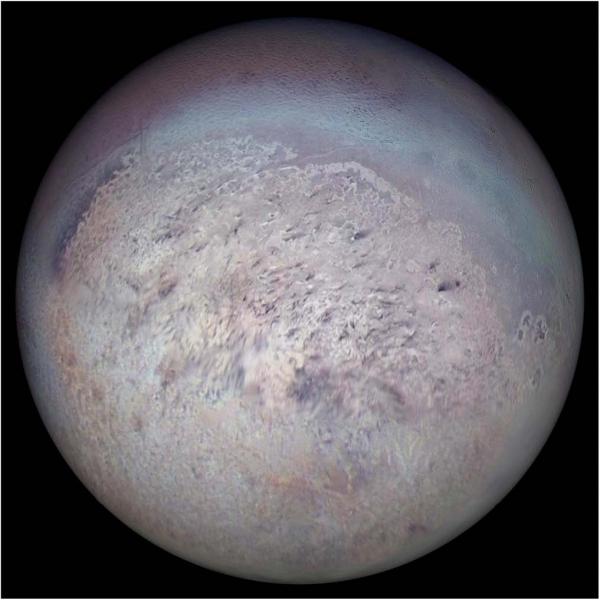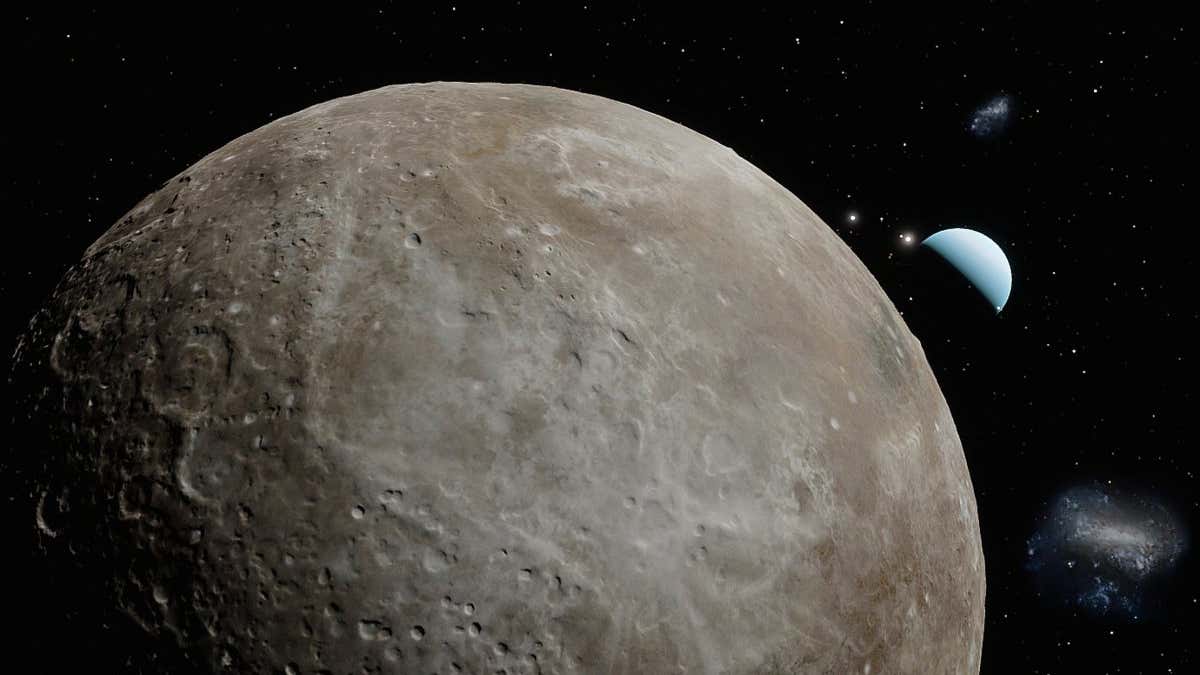*This post may contain affiliate links. This means we may make a commission if you purchase an item using one of our links*
Triton is Neptune’s largest moon, while Titania is the largest moon of Uranus. These frozen worlds have a similar composition of the rocky core and icy mantle, and their tilts and tidal locks provide them with exceptionally long seasons of up to 42 years. Still, there are significant differences, such as Triton’s retrograde orbit and volcanic activity. And Titania’s mantle that could produce ammonia to act as antifreeze and allow for liquid water.
Continue reading to discover more about these two fascinating worlds along with a more detailed breakdown of their similarities and differences below.
What Is The Moon Triton?
Table of Contents

Triton is the largest moon of Neptune, whose most unusual feature is its retrograde orbit. Triton is the only major moon in the Milky Way which orbits in the opposite direction of its planet’s rotation.
First discovered on 10th October 1846 (just 17 days after the discovery of its planet, Neptune) by British astronomer William Lassell, “Triton” comes from a merman in Greek myth; a name which perhaps stems from the composition of this faraway moon.
The diameter of Triton is approximately 2,706km, making it a similar size to Earth’s moon. However, we know that its mass is far less than the first estimates suggested because data from Voyager showed that the surface is icy and highly reflective, a less dense composition than the dark surface of our moon.
This lower density stems predominantly from the water-ice interior encasing a denser rock core. Still, the mean density of 2.06 grams per cubic cm remains higher than that of any of Saturn’s or Uranus’ moons. In addition, Triton holds more than 99.5% of the mass of everything that orbits the planet Neptune and its total mass is greater than every smaller satellite in the solar system combined.
Scientists think that Triton may be an object from the Kuiper Belt that Neptune’s gravity captured millions of years ago. This is because it shares many similarities with the dwarf planet Pluto – the best-known world within the Kuiper Belt.
This frozen world is a land of geological oddities with craters and a collection of depressions and ridges known as cantaloupe terrain. The geysers found on this moon shoot plumes of nitrogen as high as 8km high, which creates a thin atmosphere of nitrogen.
In around 3.5 billion years, Triton’s orbit will travel too close to Neptune, and the planet’s gravitational pull will break the moon apart, creating a ring system.
What Is The Moon Titania?

Titania is the biggest of Uranus’s moons, with a circumference of 4,956km and a diameter of 1576.8km. The high density of this moon suggests that it most likely formed from a collection of dust and debris leftover from the formation of Uranus or from the debris created in the collision that reportedly tilted Uranus onto its side.
First discovered on 11th January 1787 (the same day as the discovery of Oberon, the second biggest moon of Uranus) by British astronomer William Herschel, the name “Titania” comes from the Shakespeare play, A Midsummer Night’s Dream. (Most of Uranus’ moons are named after Shakespeare’s characters.)
Having observed Titania for many years, scientists theorize that its composition is likely to be equal parts ice and rock, the latter of which may contain carbonaceous materials and organic compounds.
Research suggests that the moon most likely has a rocky core (accounting for 66% of the moon’s radius) and an icy mantle. If the mantle contains ammonia, it will act as antifreeze and make it possible for liquid water to exist. In this instance, the moon could possess a layer of liquid ocean around 50km thick.
Titania tilts slightly towards the equator of Uranus and is tidally locked to its planet. The planet Uranus is also tilted, with the moons orbiting on the equatorial plane, giving it extreme seasons. On Titania, the north and south poles experience 42 years of complete sunshine followed by 42 years of total darkness.
Scientists have observed the presence of large amounts of carbon dioxide, suggesting this may be the primary component of this moon’s atmosphere. Thanks to the tilted orbit, and a concentration of solar radiation from the poles, Titania probably maintains a carbon dioxide cycle, similar to the hydrogen cycle on Earth.
How Are Triton And Titania Similar?
- Both planets have a similar composition. Triton and Titania possess rocky cores and icy mantles.
- Both Triton and Titania are the largest moons of their respective planets,
- They are both tidally locked. And they share similarly lengthy seasons of 40 years (Triton) and 42 years (Titania).
- Both moons have a surface that is littered with impact craters.
- Triton and Titania are two of the most distant moons from the Sun, with surface temperatures of -235 degrees Celsius and -203 degrees Celsius, respectively.
- Both moons have longer days than they do years, meaning they travel around their respective planets faster than they make a complete rotation on their axis.
Differences Between Triton And Titania.
- Triton is the only significant moon in our solar system with a retrograde orbit.
- Triton is named after a character in Greek myth, while Titania is the fairy Queen in one of Shakespeare’s plays.
- Titania was discovered first. Uranus’s moon was discovered in the 18th century, but Triton, Neptune’s moon, wasn’t found until the 19th century.
- Triton’s atmosphere is nitrogen-based, while Titania’s is carbon dioxide.
- One day on Triton lasts approximately 5.877 Earth days, while Titania’s “day” (the time it takes for a complete rotation on its axis) is 8.71 Earth days.
- A year on Triton is 141 hours, whereas a year on Titania is 209 hours.
- Triton is one of the only objects in the solar system to have active volcanoes (along with Earth and Jupiter’s moon, Io). Titania does not have volcanoes.
Summary
If you could travel to the distant landscapes of Triton and Titania, you would notice some striking similarities between these two icy worlds. Not only would they possess similar compositions, but the structure of days, seasons, and years would be far more similar to one another than they would to Earth.
Still, each entity has unique features that make them fascinating for scientists to study. Triton being one of the only objects in the solar system to be volcanically active and Titania potentially producing its own antifreeze are just some qualities that make these moons unique.
References
In-Depth | Triton – NASA Solar System Exploration
Triton | Facts & Composition | Britannica
Triton (Moon) Facts (space-facts.com)
10 Interesting Facts about Titania – (astronomytrek.com)
Titania Facts for Kids – Interesting Facts about Titania Moon (planetsforkids.org)

